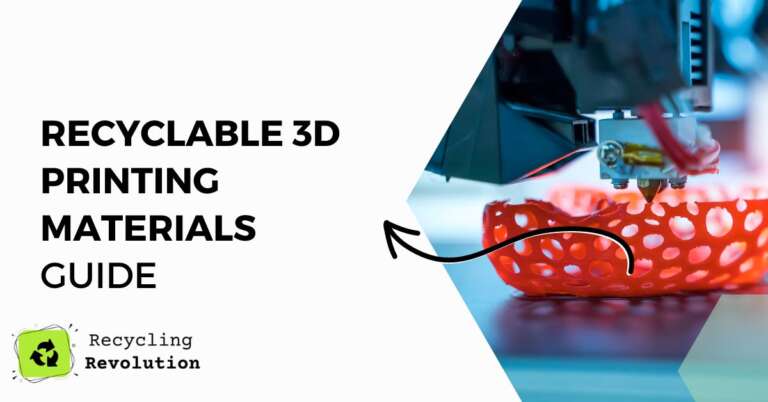3D printing technology has come a long way in recent years, and currently, some different materials are used to create 3D-printed objects.
While many of these 3D printing materials are still not recyclable, a few can be recycled and reused. Hence, this article focuses on the best ways to make your 3D printing projects more eco-friendly and recycle-friendly.
Where is 3D Printing at in 2025?
3D printing or additive manufacturing involves creating tri-dimensional solid products from a file. The production of 3D-printed objects uses additive techniques and the addition of materials in consecutive parts until it is complete. Thus, 3D printing materials are into two groups:
- Thermoplastics
- Photopolymers.
Thermoplastics are plastics that can be melted and reformed multiple times, making them ideal for 3D printing, while photopolymers are plastics cured by exposure to light and are often for creating prototypes or small-batch production runs.
On the other hand, traditional machining procedures which mainly depend on removing material through methods like cutting or drilling, are seen to be separate from 3D printing (subtractive processes). Fused deposition modeling (FDM), which uses a sustained filament of thermoplastics, is the most popular 3D printing method. The material goes into an extrusion nozzle head, melts, and extrudes layer by layer to build up the object.
This process continues to evolve as technology and new materials advance. Meaning, as various materials are now available, the uses for 3D printing technology are increasing.
Which 3D Printing Materials are Recyclable
Some of the most popular recyclable materials for 3D printing include recycling PLA, ABS, and PETG.
- PLA contains renewable resources like cornstarch or sugar cane. It is biodegradable.
- ABS is a petroleum-based plastic, non-biodegradable but recyclable. It is a durable material usually used to produce products to withstand high temps or intensive uses. Although ABS is recyclable, it is not as simple as PLA.
- PETG (sometimes known as Polyethylene terephthalate glycol) is a durable plastic usually used for food and beverage containers. It is also easy to recycle, making it an ideal choice for those who want to be eco-friendly.
Whether you are looking for an eco-friendly option, a cost-effective solution, or a material with unique properties, these recyclable 3D printing materials are excellent.
How The Materials Are Recycled
The recycling of 3D printing materials is a process that begins with the collection of used 3D printed products and filaments.
There are two main ways that 3D printing materials can be recycled: by breaking down the material into its parts or by melting and reforming the material into a new object. These methods have their pros and cons.
- Breaking down the material into its parts is the more labor-intensive of the two methods. But it allows for greater control over what new objects are created from recycled material. Since this process doesn’t involve using chemicals or high temperatures, it’s also environmentally friendly.
- Melting and reforming the materials into a new object is faster, but it results in a lower-quality recycled material. This method is also more harmful to the environment because it requires high temperatures and chemicals.
The Benefits Of Using Recyclable 3D Printing Materials
The benefits of using recyclable 3D printing materials are many. Some of the benefits are:
1. Reduces environmental waste: First, it lessens the quantity of garbage dumped in landfills. Traditional manufacturing methods often create many things that are hard to recycle or reuse. Nevertheless, 3D printing enables the production of goods with little waste. Sometimes, the waste is sent back into the filament used to create new products.
In addition, recyclable 3D printing materials decrease the carbon footprint of the manufacturing process. Meaning it helps to conserve resources and prevents pollution.
2. Create custom or unique items: The process creates highly complex dimensions or designs that might be difficult to manufacture using local manufacturing techniques.
This process enables individuals and businesses to create products specifically designed to satisfy their demands. This customization can help products to be more durable, efficient, or stylish.
3. Saves money: Saving money on manufacturing costs is another benefit of using recyclable 3D printing materials. 3D printing often requires less material than traditional manufacturing methods, which can lead to significant cost savings. In addition, 3D printing is faster than local manufacturing methods, which can further reduce manufacturing costs.
4. Helps to create jobs: Using recyclable 3D printing materials is a great way to create jobs in the recycling industry. Not only does it help to reduce the amount of waste that goes into landfills, but it also provides an opportunity for people to work in the recycling industry. It’s a fantastic method to improve the environment and increase employment opportunities.
The Challenges Of Using Recyclable 3D Printing Materials
While recyclable materials are great for the environment, they can pose some challenges:
- One challenge is that not all recyclable materials are created equal.
- Some materials are often hard to work with and can be more expensive than traditional 3D printing materials.
- The materials may not be as strong or durable as other materials, which can limit their usefulness.
- Another challenge is that some materials might not work with certain printers. This can create a hassle for those using recyclable materials and those that will probably go out of their way to find compatible materials.
Despite these challenges, recyclable materials are fantastic options for people looking for a more environmentally friendly 3D printing method. With some experimentation, the materials help in producing high-quality 3D-printed objects.
Conclusion
3D printing is like a magic machine that lets us make almost anything we can dream of! But did you know some of the stuff we use to print can be recycled? It’s like giving plastic a second life! Materials like PLA, made from plants, and PETG, which is used for water bottles, can be recycled. This means we can keep our planet greener by making less trash. Recycling these materials is awesome because it saves energy, makes less waste, and can even create jobs for people.
Sure, some 3D printing stuff can be tricky to recycle and might not be super strong, but using recyclable materials is a great way to help the Earth. Plus, it’s a cool way to save money on making things. So, when you’re 3D printing, think about using materials that can be recycled. It’s a small step for us, but a big leap for our planet!
FAQ
What are the most recyclable 3D printing materials
Plastic, metal, and wood are common 3D printing materials that can be recycled. Plastic is the most commonly recycled material in 3D printing, as it can be melted down and reused in the production of new plastic products. Metal can also be recycled through a process called smelting, in which it is melted down and reshaped into new products. Wood can be recycled by breaking it down into its component fibers and using those fibers to create new products, such as paper or particle board.
PLA vs ABS Which 3D Printing Material is more Eco-Friendly?
PLA is more eco-friendly than ABS because it derives from renewable resources like corn and produces fewer emissions, is biodegradable, and requires less energy to print than ABS.
How long does it take PLA to decompose?
The decomposition time for PLA varies depending on the specific conditions in which it is disposed of. In industrial composting facilities, it can break down within a few months, while in a home composting setup or in the natural environment, it may take much longer, potentially several years or more. It is important to note that while PLA is considered biodegradable, it is not the same as being compostable.

